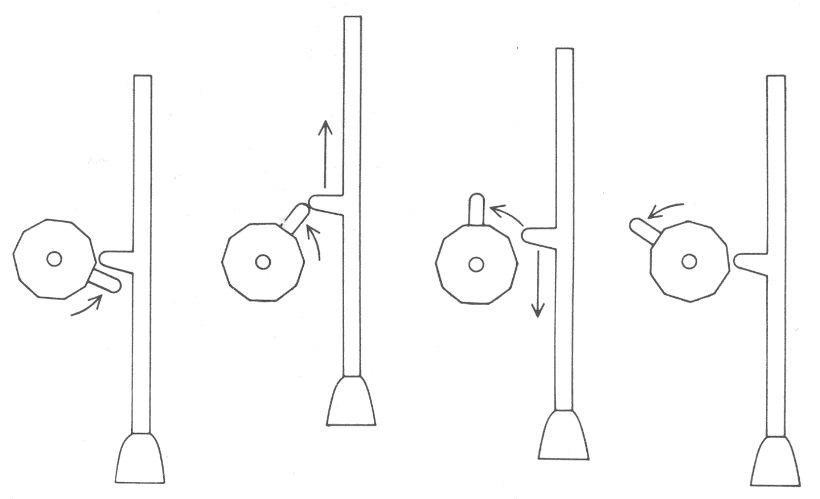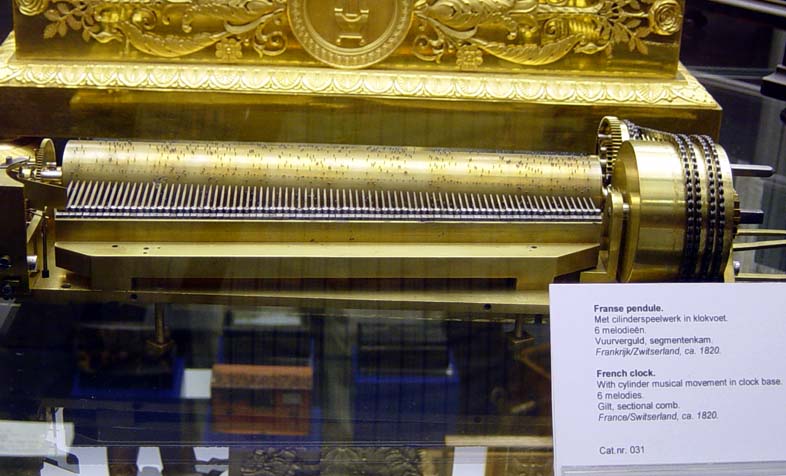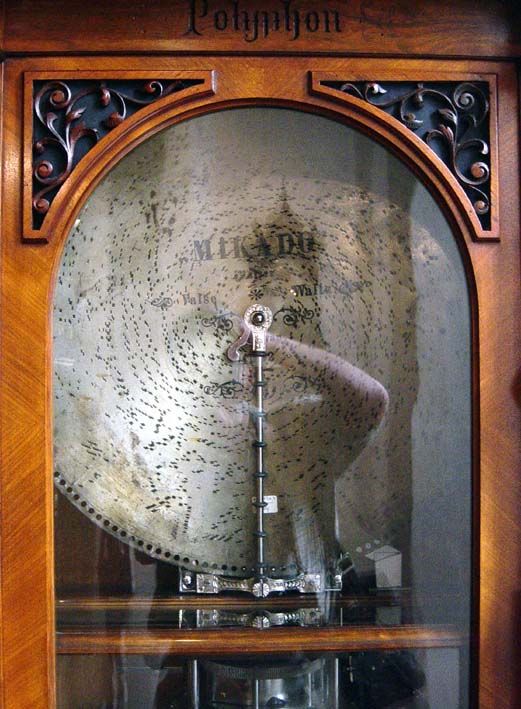From Carillon to IBM
The musical roots of information technology
2. From camshaft to musical box
So, how were automatic musical instruments programmed in Europe since the late Middle Ages? The key invention was the development of the camshaft. The camshaft is one of those little, completely anonymous technical marvels that changed the history of the world. Although there were possibly Greek/Roman, Chinese and Islamic precursors, the development of the crank and the camshaft are generally believed to be among the greatest contributions of medieval European technology.
Cams are lobes or projections on a rotating shaft and are used to transmit a motion at a predetermined time during the rotation of the shaft. In particular, cams translate a rotating movement into a reciprocal movement (up and down or back and forth), as shown in animations, or on the following picture (courtesy Scientific American):

The medieval development of camshafts has proven to be of immense technological significance. It allowed the budding medieval industry to transform the rotating movement of waterwheels and windmills into the movements that could be used for the hammering of ore, the sawing of wood and the manufacturing of paper. Especially after having been powered by the developing windmill technology, this led to the first industrial revolution in the Low Countries. Since then, the camshaft (together with the crank and toothed wheels) has been among the key parts of all (semi-)automated processes, up to the functioning of the valves in the engine of your car.
Less generally known is that the invention of the camshaft also was the key to the development of programmed musical instruments since the late Middle Ages. As in the development of the industrial processes, the camshaft can be used to translate the movement of a rotating shaft into the periodical movement of levers (up-and-down movement), in this case levers connected to the operation of bells or other musical instruments. The crucial point is that the translation of rotation into reciprocal movement through camshafts can be programmed in a very real sense.
The first controllable element is the speed of the shaft: by regulating the speed of the shaft on which the cams are mounted, one can influence the timing and speed of the movement of the follower (the up-and-down moving element driven by the impact of the rotating cams). The nature of the movement of the followers can further be programmed a) by the number of cams per rotation and b) by the shape of the cams. For instance, if the follower meets four cams per cycle, reciprocal movement (like hammering) is repeated four times. The shape of the cams determines for instance the duration of the contact with the follower, where short contact leads to punctuated follower movement, while longer contact leads to prolonged follower movement. All in all, then, the camshaft provides a natural potential to program movement. It involves a kind of mechanical memory for cyclical automated processes (the cyclicity being provided by the rotation of the shaft).
A typical industrial camshaft (as in a mill) contains only a small number of cams, but as soon as one wants to cram more cams on a shaft to represent richer information content (as determined by the nature and distribution of cams), the shaft has to be bigger and typically is given the form of a cylinder. This is the origin of the pegged cylinders everyone knows from musical boxes, in which the cams on the cylinder take the shape of needle-like elements, big enough to translate the rotating movement of the cylinder into the plucking of the teeth of the comb:

A pegged cylinder, in other words, is an extension of the camshaft and of the idea that a camshaft uses the shape and distribution of cams to store information about automated processes. Naturally, then, from their first European appearance in the 14th century to the end of the 19th century, musical automata were programmed most of the time with pegged cylinders and only occasionally with pegged disks (even mini-discs as we would call them now). I will ignore here the very interesting fact that the first documented example of a musical instrument programmed by a (wooden) pegged cylinder leads us out of Europe and to the Baghdad of the 9th century (see A Lehr, De Geschiedenis van het Astronomisch Kunstuurwerk. Den Haag, 1981, p. 227).
By the end of the 19th century the age-old
dominance of the cylinder was finally broken by the emergence
of the much more versatile and cheaper punched paper programming
(see above and below) and by the application
of cheap, easy-to-produce metal disks with holes in them.
Musical boxes with cylinders and tuned
combs were first developed in the Swiss Jura and were patented
by the Geneva watchmaker Antoine Favre in 1796. Musical boxes became
big business in the 19th century and were one of the first
success es of mass production. It is nevertheless a rigid medium that becomes
a little boring after a while. Only a very few melodies can be stored
on the cylinders, they cannot be reprogrammed, and only the more
expensive models came with more cylinders than one. No wonder,
then, that the development of the musical box with cylinder came
to an end when the more flexible media were introduced at the
end of the 19th century (metal disks, perforated paper), which in turn had an interesting
but short career themselves because of the invention of the gramophone.
es of mass production. It is nevertheless a rigid medium that becomes
a little boring after a while. Only a very few melodies can be stored
on the cylinders, they cannot be reprogrammed, and only the more
expensive models came with more cylinders than one. No wonder,
then, that the development of the musical box with cylinder came
to an end when the more flexible media were introduced at the
end of the 19th century (metal disks, perforated paper), which in turn had an interesting
but short career themselves because of the invention of the gramophone.
Curiously, Europe’s oldest musical automata were
much more flexible, because they could be programmed! From the
late Middle Ages, musical automata were developed within the context
of the then most advanced piece of technology,
the clockwork. Sophisticated clocks first appeared in Italian
towers during the 13th century. From the beginning,
turret clocks involved some kind of information technology, because
the chimes had to indicate the hour, the half hour or even the
quarter. Already in the 14th century, the so-called
going trains and striking trains of such clocks were expanded with a
musical train, automatically playing some melody, say, at every hour.
<<previous
1
| 2| 3| 4| 5| next>>